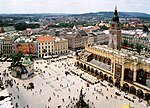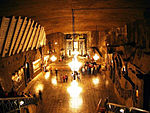This article lists the sites registered with World Heritage in Poland.
Understand
Poland ratified the Convention for the Protection of the World Cultural and Natural Heritage on June 29, 1976. The first protected sites were inscribed in 1978.
Poland has 15 sites listed in the World Heritage, 14 cultural and 1 natural.
Listing
The following sites are listed as World Heritage.
| Site | Type | Criterion | Description | Drawing | |||||||||||||||||||||
|---|---|---|---|---|---|---|---|---|---|---|---|---|---|---|---|---|---|---|---|---|---|---|---|---|---|
| 1 Auschwitz Birkenau | Cultural | (vi) | German Nazi concentration and extermination camp (1940-1945), place of memory of the Shoah. |  | |||||||||||||||||||||
| 2 Historic center of Krakow | Cultural | (iv) |  | ||||||||||||||||||||||
| 3 Warsaw Historic Center | Cultural | (ii), (vi) |  | ||||||||||||||||||||||
| 4 Castle of the Teutonic Order of Malbork | Cultural | (ii), (iii), (iv) |  | ||||||||||||||||||||||
| Wooden churches in southern Lesser Poland 5 Binarowa 6 Blizne 7 Dębno 8 Haczow 9 Lipnica Dolna 10 Sękowa | Cultural | (iii), (iv) |  | ||||||||||||||||||||||
| Churches of Peace in 11 Jawor and 12 Świdnica | Cultural | (iii), (iv), (vi) |  | ||||||||||||||||||||||
| 13 Wroclaw Centenary Hall | Cultural | (i), (ii), (iv) |  | ||||||||||||||||||||||
| 14 Kalwaria Zebrzydowska : Mannerist and landscaped architectural ensemble and pilgrimage park | Cultural | (ii), (iv) |  | ||||||||||||||||||||||
| 15 Wieliczka Salt Mines | Cultural | (iv) |  | ||||||||||||||||||||||
| 16 Muskau Park / Mużakowski Park | Cultural | (i), (iv) | Common cross-border site withGermany. |  | |||||||||||||||||||||
| Wooden tserkvas from the Carpathian region in Poland and Ukraine 17 Brunary 18 Chotyniec 19 Kwiatoń 20 Owczary 21 Powroźnik 22 Radruż 23 Smolnik 24 Turzańsk | Cultural | (iii), (iv) | Common cross-border site withUkraine. |  | |||||||||||||||||||||
| 25 Zamość old town | Cultural | (iv) |  | ||||||||||||||||||||||
| 26 Medieval Town of Toruń | Cultural | (ii), (iv) | Torun owes its origins to the Teutonic order who built a castle there in the middle of the 13th century.e century, to serve as a basis for the conquest and evangelization of Prussia. It quickly took on a commercial role within the Hanseatic League and many of the imposing public and private buildings of the XIVe and XVe centuries (including the house of Copernicus) which remain in the Old Town as in the New Town bear witness to its importance. |  | |||||||||||||||||||||
| Tarnowskie Góry lead, silver and zinc mine and its underground hydraulic management system (in Silesian Voivodeship) | Cultural | (i) (ii) (iv) | Located in Upper Silesia, one of the main mining regions of Central Europe located in southern Poland, the site includes the entire underground mining network with its galleries, shafts and access galleries as well as its hydraulic management system. Most of the property is located underground, while on the surface only a few elements remain, such as the remains of the 19th century steam pumping station.e century. This hydraulic system reflects the continuous efforts over three centuries to drain underground mining sites. It has turned the unwanted presence of water in mines into an opportunity to supply cities and industries with water. Tarnowskie Góry has made a significant contribution to the global production of lead and zinc. | .jpg/150px-Tarnowskie_Góry,_Chodnik_Obejście_-_fotopolska.eu_(339215).jpg) | |||||||||||||||||||||
| 27 Białowieża Forest | Natural | (vii) | Common cross-border site with the Belarus |  | |||||||||||||||||||||
Criteria legend
| |||||||||||||||||||||||||
